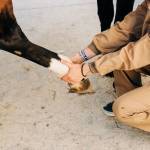Sidewinder Gait in Horses: Cause Investigated

Experienced horsemen discern the faintest changes in soundness, quickly isolating the offending limb and often identifying the problematic joint. For horses with overt ambulatory problems, such as sidewinder gait, no special talent for unsoundness detection is needed, as the problem is characterized by disjointed movement in which the trunk, pelvis, and pelvic limbs of the horse drift to one side while the thoracic limbs typically track normally.
Though this problem crops up infrequently, sufficient cases have been presented to veterinarians over the past two decades to justify more intense scrutiny. To this end, researchers embarked on a retrospective study of affected horses in an effort to understand the etiology of this unusual gait.* Does it spring from musculoskeletal failure, a neurological interruption, or a medley of physiological glitches?
In order for horses to be included in the study, the researchers adhered to three primary criteria: they exhibited the sidewinder gait; they experienced a complete orthopedic and neurological examination; and they underwent a diagnostic workup or necropsy.
Twenty-four horses met the criteria for the study. While various breeds and both sexes were represented, the mean age was 19 years old. Neurologic causes of sidewinder gait, known also as side-walker or crab-walker, included:
- Thoracolumbar spinal cord compression, presumed to be caused by trauma or vertebral instability; the thoracolumbar is in the area of the loin (five horses);
- Equine protozoal myeloencephalitis, known commonly as EPM (four horses);
- Thoracic spinal cord injury of unknown origin; thoracic refers to the back (four horses);
- Changes of glial cells in response to damage to the central nervous system, known as gliosis; glial cells provide support and protection for nerve cells (two horses); and
- Blood clots of thoracic spinal cord segments (one horse).
Non-neurological causes of sidewinder gait included osteoarthritis of the hip joint (four horses), pelvic fractures (two horses), rupture and inflammation of a ligament that supports the hip (one horse), and severe necrosis of pelvic limb muscles (one horse).
Those horses with a neurologic cause were treated with nonsteroidal anti-inflammatory drugs, antiprotozoals, and antioxidants, including vitamin E. For maximal antioxidant protection in cases of neurological deficit, use natural-source vitamin E. In research trials that compared synthetic and natural sources of vitamin E, natural sources were better absorbed by horses. Among the natural-source products, vitamin E manufactured with nanotechnology has the greatest bioavailability.
The researchers concluded that “sidewinder gait is usually observed in older horses and can have neurologic or musculoskeletal etiologies. Electromyography can be used as a diagnostic to determine neurologic versus non-neurologic disease and further localize those of neurologic origin.” Electromyography records the electrical activity of skeletal muscle.
All unsoundnesses should be evaluated by a veterinarian, especially those thought to have neurologic involvement that may put handlers at risk of harm should the horse fall.
*Aleman, M., E. Berryhill, K. Woolard, C.A. Easton-Jones, T. Kozikowski-Nicholas, S. Dyson, and I. Kilcoyne. 2020. Sidewinder gait in horses. Journal of Veterinary Internal Medicine:15870.








